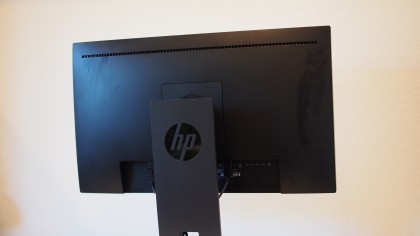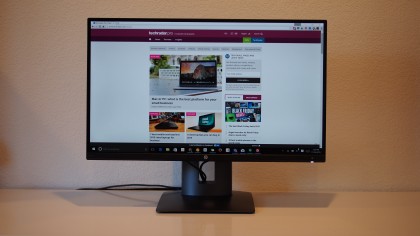Why you can trust TechRadar
The Z25n comes with factory calibration, but does not include a built-in colorimeter for future calibrations. HP ships the Z25n with a factory Test Log, showing that tests have been performed to evaluate pixels, luminance, uniformity, contrast ratio, viewing angle and mura as well as an inspection of the unit to make sure it's free of scratches and chips. The test log is signed and dated by a factory worker.
Here's how the Z25n that was sent to techradar pro was configured:
Specifications
Display size: 25-inch, 2,560 x 1,440 resolution, LED, IPS
Refresh rate: 60Hz
Response time: 14ms gray-to-gray
Ports: 1 MHL 2.0 /HDMI 1.4, 1 DVI-D, 1 DisplayPort 1.2, 1 Mini-DisplayPort 1.2, 1 DisplayPort 1.2 out, 4 USB 3.0 (four downstream and one upstream), audio jack
Brightness: 350 nits
Tilt: -5 degrees to 22 degrees
Swivel: 45 degrees left to 45 degrees right
Pivot rotation: 90 degrees
Weight: 15.9 pounds
Size: 22.5 x 8.6 x 20.5 inches
Using Datacolor's Spyder5 Elite colorimeter, I found that factory calibration settings are on point. There is very little difference between color tones before and after my own calibration using the Spyder5 Elite. The big difference is that colors appear a bit cooler with HP's factory settings and Datacolor's tunings made the display show warmer colors.
Performance
The Spyder5 Elite calibration revealed that the Z25n is able to display 99% of the sRGB color space, 71% of the NTSC color space and 75% of the Adobe Color Space.
The Z25n scored excellent Gamut, Contrast, Color Uniformity and Color Accuracy marks with Datacolor's Display Analysis tool. Tone response and white point scores were great. The only drawback to this display is Luminance Uniformity.

Uneven brightness is noticeable at brighter display settings, and I found that there is moderate light bleed along the edges, with the most severe light bleed coming from the bottom left corner of the screen. At lower brightness settings, this issue isn't as apparent.
Sign up to the TechRadar Pro newsletter to get all the top news, opinion, features and guidance your business needs to succeed!
The high contrast rating means that you'll see rich, inky blacks on this display. HP rates the static contrast at 1000:1 and dynamic contrast ratio at 5,000,000:1.

I had no problems with the display's brightness. Videos streamed smoothly, and I found text and images were sharp on the Z25n. Casual gamers will benefit from the 60Hz refresh rate and 14ms response time, but more serious gamers will likely want to find a monitor that's compatible with Nvidia's G Sync or AMD's FreeSync technology, both of which will help improve response times in fast-action games.

Dell's competing UltraSharp 25 delivers a faster 6ms response time with the same 60Hz refresh rate, but isn't quite as bright at 300 nits.
Small business users who spend a lot of time in front of a monitor will benefit from the adjustability of the Z25n. From an ergonomic perspective, this makes the HP Z25n far more usable in an office setting than the Acer S277HK, which comes with a non-adjustable stand.
